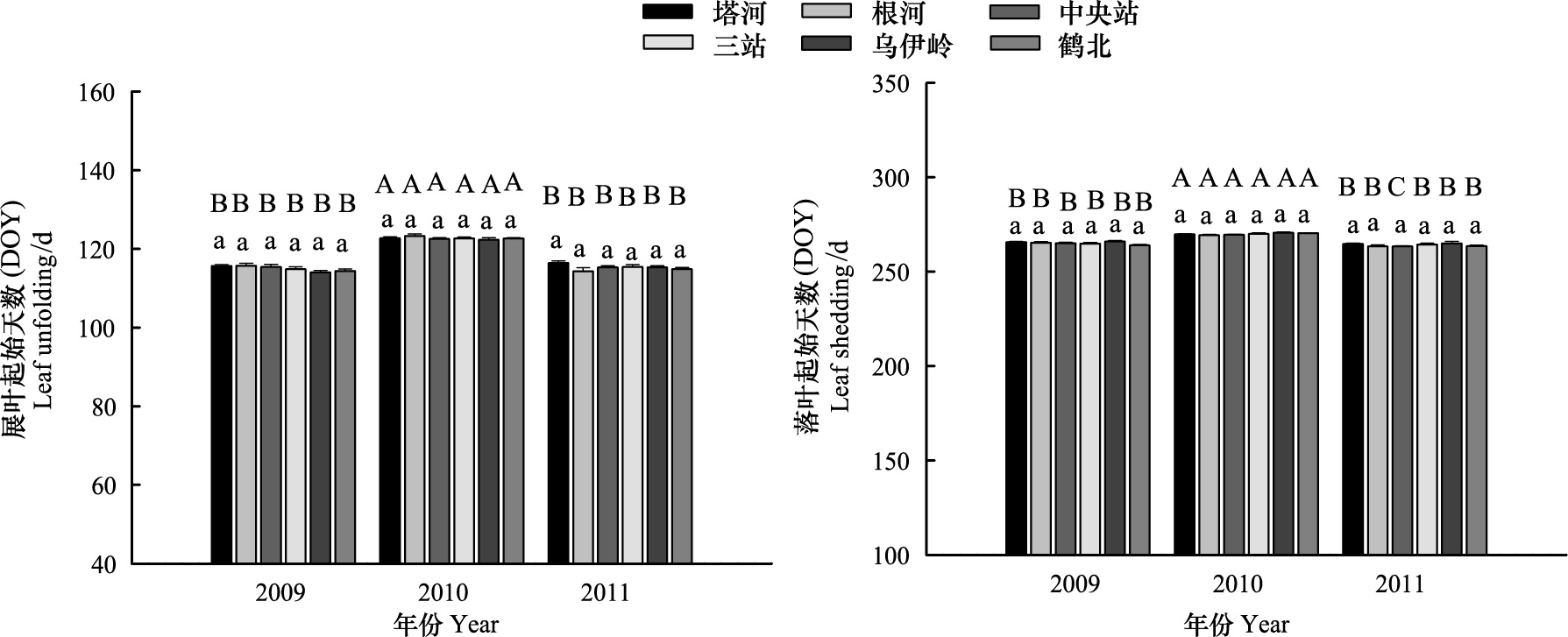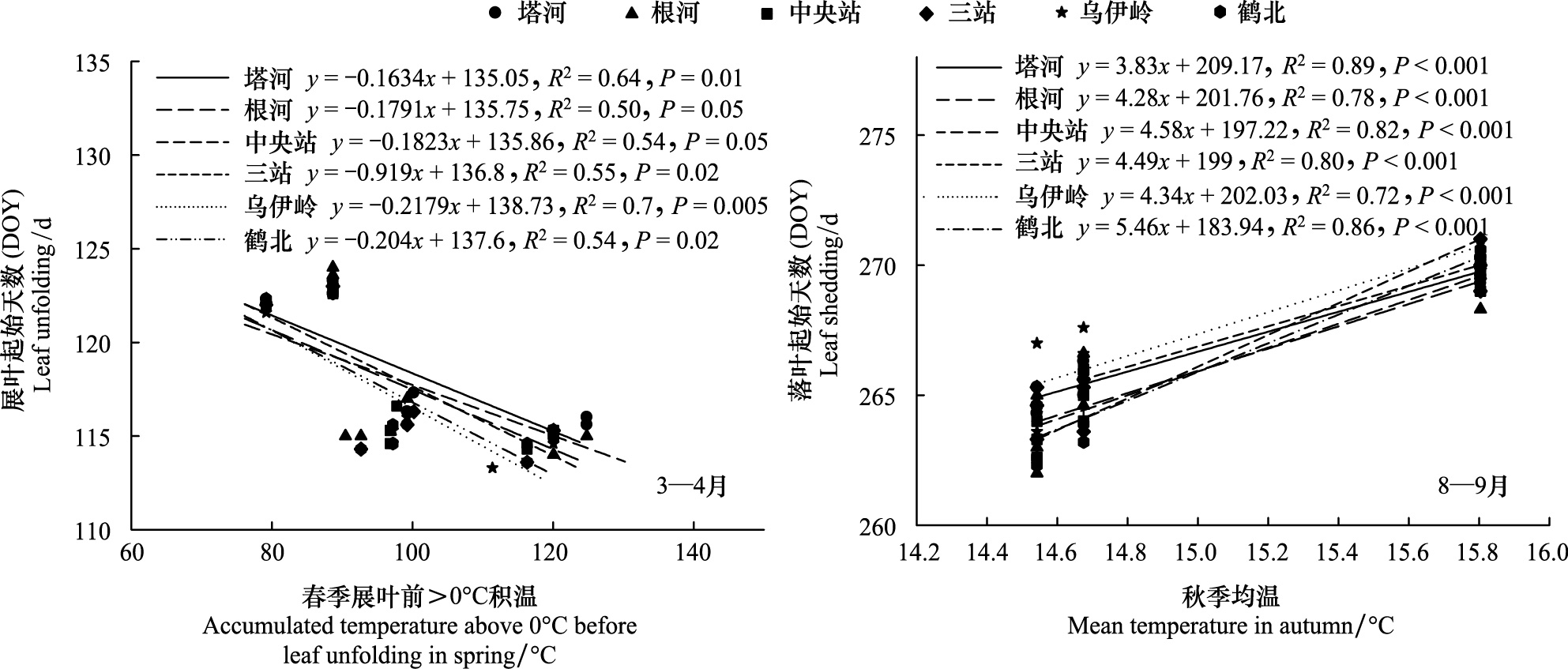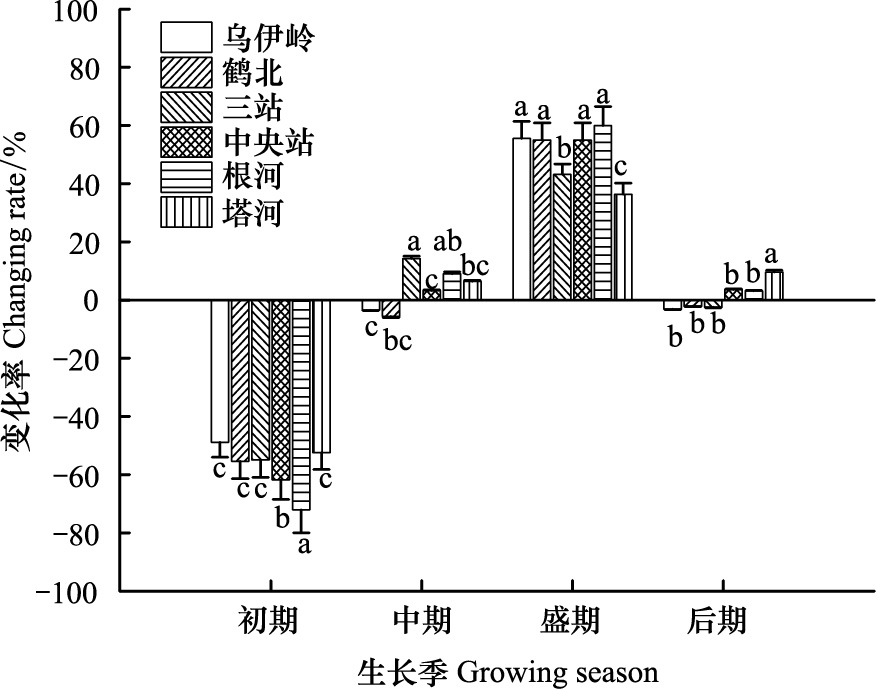文章信息
- 全先奎, 王传宽
- QUAN Xiankui, WANG Chuankuan
- 兴安落叶松对环境变化的物候驯化和光合能力适应
- Acclimation of leaf phenology and adaptation of photosynthetic capacity of Larix gmelinii to environmental changes
- 生态学报, 2015, 35(13): 4538-4546
- Acta Ecologica Sinica, 2015, 35(13): 4538-4546
- http://dx.doi.org/10.5846/stxb201404070661
-
文章历史
- 收稿日期:2014-04-07
- 网络出版日期:2015-04-09
兴安落叶松是欧亚北方森林的优势树种,也是我国北方森林的主要建群种,其林地面积和蓄积分别约占全国森林总面积和总蓄积的4.36%和5.31%[1],在我国森林碳平衡中占有重要地位。基于植被区划、物种分布区与环境变量的对应关系以及从统计学角度就物种地理分布对气候变化响应的研究认为,我国兴安落叶松林分布区将随着全球气候变暖而北移,甚至可能全部北移出境,然而,这些预测尚需实测数据的验证[2, 3, 4, 5]。
物候既能直观地指示植物发育的季节变化,还能表现出植物对自然环境变化的适应。目前关于植物物候学的研究多集中在对野外观测的初步统计分析,而植物物候的改变是其对环境变化的一种驯化,还是基因调控下的适应,目前还不是很清楚[6, 7]。已有同质种植园(common garden)种源试验研究表明来自于高纬度/海拔地区的种源发芽和展叶晚于低纬度/海拔地区种源,并且种源间物候差异是对原地气候长期适应的结果[8, 9, 10, 11, 12, 13, 14, 15, 16],然而,有些研究却表明在同质种植园内不同种源树木间发芽和展叶没有明显的差异[6, 14, 17, 18]。取样种源地理跨度(海拔,纬度)的大小、观察时间的长短、观察树木的种类及其个体差异(幼苗,大树)都会引起物候观测结果的差异,然而这些因素影响物候的具体原理还有待于深入研究。本实验前期研究表明17个兴安落叶松种源7年生幼苗物候也存在明显差异,且与种源原地气候关系紧密[19];随树木生长发育进程,已为成树的兴安落叶松物候是否仍存在种源差异还不清楚。
树木光合作用是森林生态系统碳代谢过程中最重要的环节之一,由于叶片物候和气候条件的季节差异,导致叶片光合作用具有明显的季节动态[20, 21, 22, 23]。目前关于树木光合能力的种源差异研究多集于生长季中一次取样,光合能力的季节动态是否会影响种源间树木光合能力的比较还不清楚[24, 25, 26, 27, 28, 29]。以往研究表明,6种源兴安落叶松光合能力存在明显的种源差异[30],但对光合能力的季节动态及其对种源差异的影响尚未深入研究。
本研究测定了同质种植园内32年生6个种源兴安落叶松物候和光合能力季节动态,旨在探索兴安落叶松物候和光合能力的季节动态是否存在种源差异?如果有,则该差异是表型驯化作用还是基因调控下的适应?这些问题的揭示,有助于理解和预测该树种对气候变化的响应适应特征。
1 材料和方法 1.1 研究地概况本实验所用的同质种植园位于东北林业大学帽儿山森林生态系统研究站(45°24′N,127°40′E)。在兴安落叶松国内的自然分布范围内,在以表征能量差异为主的纬度和经度梯度上选取代表性种源17个,于1980年秋采种,1981年育苗,1983年春造林,1997年和2001年间伐两次,株行距现为4. 5 m × 2. 5 m[31]。同质园内土壤、地形、气候条件一致,平均海拔300 m,平均坡度10—15°,地带性土壤为暗棕色森林土。气候属于大陆性温带季风气候,1989—2009年平均降雨量629 mm,年均蒸发量864 mm,年平均温度3.1 ℃,1月和7月份平均气温分别为-18.5 ℃和22 ℃[32]。
1.2 物候观测2009—2011年在17种源中选取具有代表性6种源进行物候观测(表 1),每个种源选取3株标准木作为观测对象,每株树上选取3—5个标准枝为观察对象,然后在每株标准树周围搭建触及冠层(14 m左右)高的木架,以便物候观测及叶片光合活体测定。观测的物候相包括叶芽膨大、开始展叶、完全展叶、新枝条开始生长、新枝条停止生长、开始落叶。对物候变化较快的阶段,如萌动发芽期、展叶期和落叶期是每周观察二次,而其他阶段则为一周观测一次。以超过半数的观察枝数达到某一物候相的日期作为某标准树该物候相出现的日期,所有标准树达到某物候像日期的均值作为种源该物候相出现的日期。
1.3 光合测定每株标准木选取冠层上部向阳方的当年生枝新生叶3簇,于2009—2011年每月(5—9月)中旬,选择无雨天气于6:30—12:00时段,采用Li-6400便携式CO2/H2O红外分析仪(Li-Cor,NB,USA)活体测定针叶气体交换过程以及相应的环境因子。测定时设定的叶室环境为:温度25 ℃,外界空气进入叶室的流速500 μmol/s,CO2浓度400 μmol CO2/mol。测定前采用饱和光强对叶片进行充分光诱导。在测定光响应曲线时,光量子通量密度(PPFD)梯度为: 2000、1500、1200、800、400、200、150、100、50、0 μmol 光子 m-2 s-1。光响应曲线采用Prado和Demoraes[33]非线性方程进行拟合:
式中,Pmax为最大净光合速率(即光合能力),k为常数,Pn是实际测定的净光合速率,PAR是光合有效辐射,LCP为光补偿点。
1.4 数据分析以每株标准木为统计单位,各种源标准木的平均值代表该种源整体水平。每年的5和6月份定义为生长季初期,7、8、9月分别定义为生长季中期、盛期和后期。应用SPSS13.0统计软件对数据进行相关分析和方差分析,并用Ducan法进行多重比较,方差分析前对所有数据进行方差齐性检验和正态分布检验。论文中图和表分别采用Sigmaplot 9.0和excel 2007绘制。
2 结果 2.1 物候3a的观测结果显示6个种源兴安落叶松具有相似的物候期,方差分析表明叶片展叶和落叶开始时间在种源间均不存在显著差异,但在年际间存在显著性差异(P<0.05)(图 1)。6种源叶芽均在4月中下旬开始膨大并展叶,9月下旬开始落叶。随着年际间温度的差异,6个种源叶物候表现出相似的变化规律:叶片展叶起始日期和春季展叶前> 0 ℃积温均显著负相关(P<0.05),而落叶起始日期和秋季均温均显著正相关(P<0.001),且各种源间具有相近的敏感系数(图 2)。6种源兴安落叶松在2009、2010及2011年内的生长季天数范围分别为150—153d、145—147d和148—151d。

|
| 图 1 兴安落叶松物候种源和年际比较(2009—2011年) Fig.1 Comparisons of phenological events for Larix gmelinii trees originating from six provenances for the period of 2009—2011 图中误差线为标准误(n=9),大写字母和小写字母分别表示每个种源3年间和每一年内6个种源间Duncan检验显著性差异组(α =0.05); DOY:表示从每年的1月1日起的天数 |

|
| 图 2 兴安落叶松物候和生长季温度关系 Fig.2 Relationships between leaf unfolding dates and accumulated temperature above 0 ℃ in spring (from 1 March to 4 May), and between leaf shedding dates and mean autumn temperature (from 1 August to 30 September) for Larix gmelinii DOY:表示从每年的1月1日起的天数 |
6个种源兴安落叶松Pmax季节变化均为单峰型,但具有明显不同的季节动态(图 3和图 4)。来自于高纬度的根河、中央站、塔河种源Pmax仅在生长季初期明显低于其各自的年均值,并且变化率显著高于其他种源(塔河种源除外)(P<0.05),而在其他阶段则在年均值以上;来自低纬度的鹤北和乌伊岭种源Pmax仅在生长盛季明显高于其各自年均值,而在其他阶段则处于年均值以下;来自中纬度的三站种源Pmax在生长初期和后期小于其年均值,而在其他阶段则高于年均值(表 1和图 4)。此外,在每个生长阶段Pmax均存在显著的种源差异(P<0.05),但差异趋势随生长季进程而有所不同:在生长季初期根河种源具有最小Pmax,其它种源Pmax则相近;在生长季中期和盛期中央站和根河种源具有最大Pmax,塔河种源具有最小值;而在生长后期乌伊岭种源具有最小Pmax(图 4)。Pmax总体平均值分别为:中央站(11.54 μmol CO2 m-2 s-1)> 根河(10.01 μmol CO2 m-2 s-1)> 鹤北(9.52 μmol CO2 m-2 s-1)> 三站(9.26 μmol CO2 m-2 s-1)> 乌伊岭(7.78 μmol CO2 m-2 s-1)> 塔河(7.05 μmol CO2 m-2 s-1)。

|
| 图 3 兴安落叶松6个种源最大净光合速率(Pmax)季节动态(n=9) Fig.3 Seasonal dynamics of light saturated net photosynthetic rate (Pmax)for Larix gmelinii originating from six provenances(n=9) 图中误差线为标准误(n=9),小写字母表示Duncan检验显著性差异组(α =0.05) |

|
| 图 4 兴安落叶松6个种源生长季内最大净光合速率(Pmax)变化率(n=9) Fig.4 Changing rate of light saturated net photosynthetic rate (Pmax) for six Larix gmelinii provenances in growing season 变化率=((某阶段Pmax -年均Pmax)/年均Pmax) ×100%; 图中误差线为标准误(n=9),小写字母表示Duncan检验显著性差异组(α =0.05) |
| 种源 Provenance | 纬度 Latitude/ (°N) | 经度 Longitude/ (°E) | 海拔 Altitude/ m | 年均温 MAT/ ℃ | 年均降水 MAP/ mm | 年均蒸发量 MAE/ mm | ≥10 ℃积温 CT/℃ | 相对湿度 RH/% | 日照时数 SH/h | 无霜期 FFP/d |
| MAT,MAP,MAE,RH,SH,CT and FFP stand for mean annual air temperature,mean annual precipitation,mean annual evaporation,mean relative humidity,mean sunlight hours,accumulated temperature above 0℃,mean frost free period,respectively | ||||||||||
| 塔河 | 52.19 | 124.22 | 357.4 | -2.3 | 467.44 | 970.66 | 1671.38 | 68 | 2318.9 | 89.7 |
| 根河 | 50.62 | 121.95 | 979.9 | -0.5 | 466 | 1100 | 1297.6 | 70 | 2678 | 81.4 |
| 中央站 | 50.45 | 125.2 | 230 | 0.58 | 482.48 | 1370.08 | 1780 | 69 | 2500 | 100 |
| 三站 | 49.62 | 126.8 | 160 | -0.29 | 534.99 | 1125.51 | 1650 | 69.5 | 2655 | 90 |
| 乌伊岭 | 48.67 | 129.42 | 300 | -0.49 | 569.78 | 1043.16 | 1851.22 | 72.6 | 2235.12 | 104.9 |
| 鹤北 | 47.55 | 130.42 | 120 | 2.6 | 554.33 | 1237.79 | 2456 | 74 | 1987.2 | 139 |
以往种源试验研究表明来自于高纬度地区的种源发芽和展叶晚于低纬度地区种源[8, 10, 11, 13],具有较短生长季[13, 28],相似的结果在不同海拔高度种源间也得以体现[14, 15],并且认为这种种源间的物候差异是对原地气候长期适应的结果。而本研究结果表明来自于6个不同纬度兴安落叶松种源具有相似的物候期,各物候事件同步发生,生长季天数相差在3d以内(图 1),这与杨传平等[19]对相同种源7年生幼苗展叶期相差8d、生长季相差18d结果存在明显不同。出现这种结果的原因与种源实验所采用的树木发育状况有关。当种源实验
以幼苗作为观察对象时,其对新环境条件的适应需要一定时间,生长发育仍受到种源原地气候状况的影响,所以物候会表现出一定的纬度或海拔差异。如,来自高纬度种源发芽展叶较晚,一是对光周期的需求,另一方面是为了避免早春霜冻的伤害[13, 14, 15, 28]。随着树木的生长和对新环境逐步适应,其物候也逐渐与当地气候相同步,从而种源间的物候差异也逐渐缩小。Lukkarinen等[34]对同质园内5个兴安落叶松种源生长节律研究发现种源间发芽率在开始阶段差异明显,但在后期却差异不明显,并且差异的趋势并不是随着纬度的变化而呈现响应的变化,生长的开始和结束主要受到温度和光周期的影响。对32个欧洲山毛榉(Fagus sylvatica)种源的叶物候研究表明展叶时间还受到树木个体差异的影响,生长较快的树木展叶早并且和季节霜冻间无明显关系[35]。在温带和寒带地区,控制植物物候变化的主要因素有光周期、温度及其持续天数,气候变化条件下这些因素如何综合影响植物物候还需深入研究[7, 36]。另一方面,由于受到表型可塑性的影响,树木的生长发育会随着环境的变化而改变,在长期的进化过程中使自身的适合度达到最大[37]。本研究发现,春季展叶前 > 0 ℃积温每增加10 ℃,叶片展叶起始日期随着纬度的减小而有序的提前1.63—2.18 d;而秋季每提高1 ℃叶片则晚落叶3.83—5.46 d(图 2)。有研究表明叶物候在年际间有一定的波动,除了受到不同时间尺度(日,周,月,年)大气均温的影响外,还受到其持续期积温、降水、土壤温度等环境因子的综合控制[38, 39, 40],随着观察年限的增长,叶片物候和环境因子间的关系会发生怎样的变化还需进一步研究。虽然本研究结果仅为3a数据分析所得,但总体而言6种源树木物候均受生长季温度的控制并表现出一定的趋同性,这是对温度变化的一种表型性适应,相似的研究结果在其他报道中也得以体现[17, 18, 41]。兴安落叶松物候的可塑性一方面会使其随着环境的变化而改变生活习性,增大自身的适合度,减轻气候变化带来的影响;另一方面,物候的改变会导致树木的生长时间发生变化,由于光合和呼吸等生理过程的作用,势必会改变大气中CO2的浓度,从而反作用于气候变化。
3.2 光合能力季节动态树木光合能力由于受外界温度、降水、日照等环境因子的综合作用而表现出一定的季节规律,同时又因树木自身生物学特性的影响而表现出相异的季节动态[20, 23] 。本研究中虽然6个种源兴安落叶松树木Pmax随生长季温湿度变化均呈单峰型季节格局,但种源间具有明显不同的Pmax季节动态(图 3和图 4)。这是不同种源树木光合生理对种源原地气候条件长期适应的一种反映:高纬度/低温地区由于生长季起步较晚,因此树木在生长季初期Pmax启动要晚于低纬度/高温地区种源;而当外界温湿度等条件适宜后高纬度/低温树木Pmax对温度具有更高的温度敏感性而迅速增强,并在生长后期温度降低的情况下仍保持高水平的光合能力[13, 14, 15, 26, 28]。通过分析生长季内Pmax和温度的关系发现6个种源树木Pmax均与温度存在显著正线性关系(P<0.01),并且来自较高纬度的中央站、根河、三站种源树木Pmax随温度升高的增幅程度明显高于低纬度种源树木,这也进一步支持了本文的结论(图 5)。该结果也表明随着气温的升高,高纬度地区兴安落叶松树木单叶水平的固碳能力有增加的趋势。

|
| 图 5 兴安落叶松6个种源最大净光合速率(Pmax)和同质种植园内生长季温度关系 Fig.5 Light saturated net photosynthetic rate(Pmax)for six Larix gmelinii provenances in relation to the seasonal temperature of common garden |
6个种源兴安落叶松Pmax既表现出明显的季节动态差异,又在每个生长阶段具有显著的种源差异(P<0.05),表明光合能力已对种源原地的气候产生适应,仍受到种源原地气候条件的影响。季子敬等[42]对兴安落叶松针叶解剖结构和光合生理进行了研究,结果表明针叶的解剖结构特征参数存在显著的种源间差异(P<0.05),从而引起其针叶光合生理发生相应的变化,这是对种源原地气候条件的长期适应的结果,这与赵晓炎等[30]研究结果相似。与以往研究不同的是,虽然Pmax存在显著的种源差异(P<0.05),但差异趋势和程度在每个生长阶段以及整个生长季均有所不同。在生长季初期根河种源具有最小Pmax,种源间的变异系数为11.52%;而在生长盛期塔河具有最小Pmax值,种源间的变异系数高达21.06%。该结果的出现既与种源自身的生物学特性相关,又和种源对现生长地气候的驯化程度有关。总之,如果仅通过一次的测定结果而对种源间Pmax大小进行比较的话会造成误判,在与种源原地气候条件进行相关分析的时候也容易得到相悖的结果,因此采用生长季内多次测量数据进行统计分析不仅会得到更为准确的结果,而且有助于人们深入了解树种对环境变化的响应和适应。
4 结论6个种源树木具有相似的物候期,叶片的展叶和落叶起始天数种源差异均不显著,并且分别与春季展叶前 > 0 ℃积温和秋季均温显著相关(P<0.05),这表现出物候对环境变化的表型驯化效应。6个种源树木的最大净光合速率(Pmax)表现出不同的季节动态:来自于高纬度种源树木的Pmax在生长季中期、后期、盛期和后期均在年均值以上,来自低纬度种源树木的Pmax仅在生长盛期明显高于其各自年均值。在每个生长阶段Pmax均存在显著的种源差异:中央站种源在每个生长阶段都具有最高的Pmax,而根河、塔河、乌伊岭种源分别在生长季初期、中期和盛期、后期具有最小Pmax。这种光合能力的差异是基因调控下的树木对种源原地气候条件长期适应的结果。兴安落叶松的物候可塑性和光合能力广适性对其能在广阔多样的生境中繁衍生存具有重要的现实意义。
致谢: 黑龙江帽儿山森林生态系统国家野外科学观测研究站和林木遗传育种国家重点实验室提供野外基础支持。
| [1] | 国家林业局. 中国森林资源图集——第七次全国森林资源清查. 北京: 中国林业出版社, 2010. |
| [2] | Leng W F, H S He, and H J Liu. Response of larch species to climate changes. Journal of Plant Ecology, 2008. 1(3): 203-205. |
| [3] | 张新时. 研究全球变化的植被-气候分类系统. 第四纪研究, 1993, (2): 157-169. |
| [4] | 李峰, 周广胜, 曹铭昌. 兴安落叶松地理分布对气候变化响应的模拟. 应用生态学报, 2006, 17(12): 2255-2260. |
| [5] | 蒋延玲, 周广胜. 兴安落叶松林碳平衡和全球变化影响研究. 应用生态学报, 2001, 12(4): 481-484. |
| [6] | Vitasse Y, G Hoch, C F Randin, A Lenz, C Kollas, J F Scheepens, and C Korner. Elevational adaptation and plasticity in seedling phenology of temperate deciduous tree species. Oecologia, 2013. 171(3): 663-678. |
| [7] | 莫非, 赵鸿, 王建永, 强生才, 周宏, 王绍明, 熊友才. 全球变化下植物物候研究的关键问题. 生态学报, 2011, 31(9): 2593-2601. |
| [8] | Deans J and F Harvey. Phenologies of sixteen European provenances of sessile oak growing in Scotland. Forestry, 1995. 68(3): 265-274. |
| [9] | Mimura M and S Aitken. Adaptive gradients and isolation-by-distance with postglacial migration in Picea sitchensis. Heredity, 2007. 99(2): 224-232. |
| [10] | Von Wuehlisch G, D Krusche, and H Muhs. Variation in temperature sum requirement for flushing of beech provenances. Silvae Genetica, 1995. 44: 343-345. |
| [11] | Ducousso A, J Guyon, and A Kremer. Latitudinal and altitudinal variation of bud burst in western populations of sessile oak (Quercus petraea (Matt) Liebl). Annales des Sciences Forestieres, 1996. 53(2/3): 775-782. |
| [12] | Oleksyn J, M G Tjoelker, and P B Reich. Adaptation to changing environment in Scots pine populations across a latitudinal gradient. Silva Fennica, 1998. 32(2): 129-140. |
| [13] | Chmura D and R Rozkowski. Variability of beech provenances in spring and autumn phenology. Silvae Genetica, 2002. 51(2/3): 123-127. |
| [14] | Vitasse Y, S Delzon, C C Bresson, R Michalet, and A Kremer. Altitudinal differentiation in growth and phenology among populations of temperate-zone tree species growing in a common garden. Canadian Journal of Forest Research, 2009. 39(7): 1259-1269. |
| [15] | Alberto F, L Bouffier, J M Louvet,J B Lamy, S Delzon, and A Kremer. Adaptive responses for seed and leaf phenology in natural populations of sessile oak along an altitudinal gradient. Journal of Evolutionary Biology, 2011. 24(7): 1442-1454. |
| [16] | Vitasse Y, Delzon S, Bresson CC, Michalet R, Kremer A. Altitudinal differentiation in growth and phenology among populations of temperate-zone tree species growing in a common garden. Canadian Journal of Forest Research, 2009, 39(7): 1259-1269. |
| [17] | Vitasse Y, S Delzon, E Dufrene, J Y Pontailler, J M Louvet, A Kremer, and R Michalet. Leaf phenology sensitivity to temperature in European trees: Do within-species populations exhibit similar responses?. Agricultural and Forest Meteorology, 2009. 149(5): 735-744. |
| [18] | Vitasse Y, C C Bresson, A Kremer, R Michalet, and S Delzon. Quantifying phenological plasticity to temperature in two temperate tree species. Functional Ecology, 2010. 24(6): 1211-1218. |
| [19] | 杨传平, 张维, 于秉君, 秦泗华, 桑作兴, 张丽霞, 盛喜东, 董岐. 中国兴安落叶松种源试验的研究 (Ⅰ)——地理变异规律和模式. 东北林业大学学报, 1990, 18: 17-24. |
| [20] | Han Q, T Kawasaki, T Nakano, and Y Chiba. Spatial and seasonal variability of temperature responses of biochemical photosynthesis parameters and leaf nitrogen content within a Pinus densiflora crown. Tree Physiology, 2004. 24(7): 737-744. |
| [21] | Medlyn B E, D Loustau, and S Delzon. Temperature response of parameters of a biochemically based model of photosynthesis. I. Seasonal changes in mature maritime pine (Pinus pinaster Ait.). Plant Cell and Environment, 2002. 25(9): 1155-1165. |
| [22] | Eamus D, B Myers, G Duff, and D Williams. Seasonal changes in photosynthesis of eight savanna tree species. Tree Physiology, 1999. 19(10): 665-671. |
| [23] | Reich P, M Walters, and D Ellsworth. Leaf age and season influence the relationships between leaf nitrogen, leaf mass per area and photosynthesis in maple and oak trees. Plant, Cell and Environment, 1991. 14(3): 251-259. |
| [24] | Soolanayakanahally R Y, R D Guy, S N Silim, E C Drewes, and W R Schroeder. Enhanced assimilation rate and water use efficiency with latitude through increased photosynthetic capacity and internal conductance in balsam poplar (Populus balsamifera L.). Plant Cell and Environment, 2009. 32(12): 1821-1832. |
| [25] | Robson T M, D Sánchez-Gómez, F J Cano, and I Aranda. Variation in functional leaf traits among beech provenances during a Spanish summer reflects the differences in their origin. Tree Genetics & Genomes, 2012. 8: 1111-1121. |
| [26] | Bresson C C, Y Vitasse, A Kremer, and S Delzon. To what extent is altitudinal variation of functional traits driven by genetic adaptation in European oak and beech? Tree Physiology 2011. 31: 1164-1174. |
| [27] | Lewis J D, N G Phillips, B A Logan, C R Hricko, and D T Tissue. Leaf photosynthesis, respiration and stomatal conductance in six Eucalyptus species native to mesic and xeric environments growing in a common garden. Tree Physiology, 2011. 31: 997-1006. |
| [28] | Oleksyn J, J Modrzýnski, M Tjoelker, R Żytkowiak, P Reich, and P Karolewski. Growth and physiology of Picea abies populations from elevational transects: common garden evidence for altitudinal ecotypes and cold adaptation. Functional Ecology, 1998. 12(4): 573-590. |
| [29] | Reich P, J Oleksyn, and M Tjoelker. Needle respiration and nitrogen concentration in Scots pine populations from a broad latitudinal range: a common garden test with field-grown trees. Functional Ecology, 1996. 10(6): 768-776. |
| [30] | 赵晓焱, 王传宽, 霍宏. 兴安落叶松(Larix gmelinii)光合能力及相关因子的种源差异. 生态学报, 2008, 28(8): 3798-3807. |
| [31] | 杨传平, 姜静, 唐盛松, 李景云, 王会仁. 帽儿山地区 21 年生兴安落叶松种源试验. 东北林业大学学报, 2002, 30(6): 1-5. |
| [32] | Sang Y, C Wang, Huo H. Inter-specific and seasonal variations in photosynthetic capacity and water use efficiency of five temperate tree species in northeastern China. Scandinavian Journal of Forest Research, 2011,26(1):21-29. |
| [33] | Prado C and J d Moraes. Photosynthetic capacity and specific leaf mass in twenty woody species of Cerrado vegetation under field conditions. Photosynthetica, 1997. 33(1): 103-112. |
| [34] | Lukkarinen A J, S Ruotsalainen, H Peltola, and T Nikkanen. Annual growth rhythm of Larix sibirica and Larix gmelinii provenances in a field trial in southern Finland. Scandinavian Journal of Forest Research, 2013. 28(6): 518-532. |
| [35] | Robson T M, E Rasztovits, P J Aphalo, R Alia, and I Aranda. Flushing phenology and fitness of European beech (Fagus sylvatica L.) provenances from a trial in La Rioja, Spain, segregate according to their climate of origin. Agricultural and Forest Meteorology, 2013. 180(0): 76-85. |
| [36] | Polgar C A, Primack R B. 温带森林展叶物候学. 生物多样性, 2013, 21(1): 111-116. |
| [37] | Peñuelas J, T Rutishauser, and I Filella. Phenology feedbacks on climate change. Science, 2009. 324(5929): 887. |
| [38] | 常兆丰, 韩福贵, 仲生年. 民勤荒漠区36种植物物候期积温变化动因分析. 中国农学通报, 2010, 26(10): 295-302. |
| [39] | 韩福贵, 徐先英, 王理德, 王键, 张应昌, 韩生慧. 民勤荒漠区典型草本植物马蔺的物候特征及其对气候变化的响应. 生态学报, 2013, 33(13): 4156-4164. |
| [40] | 马利苹, 王力华, 阴黎明, 刘波, 陈玮. 乌丹地区文冠果生物学特性及物候观测. 应用生态学报, 2008, 19(12): 2583-2587. |
| [41] | Matsumoto K, T Ohta, M Irasawa, and T Nakamura. Climate change and extension of the Ginkgo biloba L. growing season in Japan. Global Change Biology, 2003. 9(11): 1634-1642. |
| [42] | 季子敬, 全先奎, 王传宽. 兴安落叶松针叶解剖结构变化及其光合能力对气候变化的适应性. 生态学报, 2013, 33(21): 6967-6974. |
 2015, Vol. 35
2015, Vol. 35





